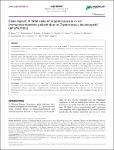Case report: A fatal case of cryptococcosis in an immunocompetent patient due to Cryptococcus deuterogattii (AFLP6/VGII)
Bauer, M.
Wickenhauser, C.
Haak, A.
Pazaitis, N.
Siebolts, U.
Mawrin, C.
Strauss, C.
Rickerts, V.
Stoevesandt, D.
Cornely, O. A.
Meis, J. F.
Hagen, F.
Introduction. Cryptococcosis in immunocompetent adults is a rare disease in Europe, mostly induced by members of the Cryptococcus gattii species complex. The diagnosis can be challenging due to its rarity, unspecific symptoms and long symptomless latency.
Case presentation. A 49-year-old woman with a three weeks history of headache was admitted to the hospital due to discrete ataxia and impaired vision. Cranial magnetic resonance imaging (MRI) showed a contrast-enhancing mass in the cerebellum. Further investigations detected a slight leukocytosis and a single subpleural nodule in the right inferior lung lobe. The cerebral lesion was surgically removed, and a direct frozen section only showed an unspecific inflammation. In the course of her admission she developed non-treatable cerebral edema and died ten days after surgical intervention. Histopathological examination of the surgical specimen and postmortem evaluation of the lung and the cerebrum demonstrated fungal elements. Molecular identification of the fungal elements in formalin-fixed paraffin-embedded tissue lead to the diagnosis of cryptococcosis induced by C. gattii sensu lato. Molecular genetic analysis identified the involved cryptococcal species as genotype AFLP6/VGII, recently described as Cryptococcus deuterogattii, which is known to be endemic to the west-coast of Canada and the USA. Additional heteroanamnestic information revealed that she had spent her holidays on Vancouver Island, Canada, two years before disease onset, indicating that infection during this stay seems to be plausible.
Conclusion. Cryptococcosis due to C. deuterogattii is a rarely encountered fungal disease in Europe, not particularly associated with immunodeficiency, and infection is likely to be contracted in endemic areas. Due to its rarity, long symptomless latency, unspecific symptoms and misleading radiological features the diagnosis can be challenging. Physicians need to be aware of this differential diagnosis in immunocompetent patients, as early adequate therapy can be lifesaving.

